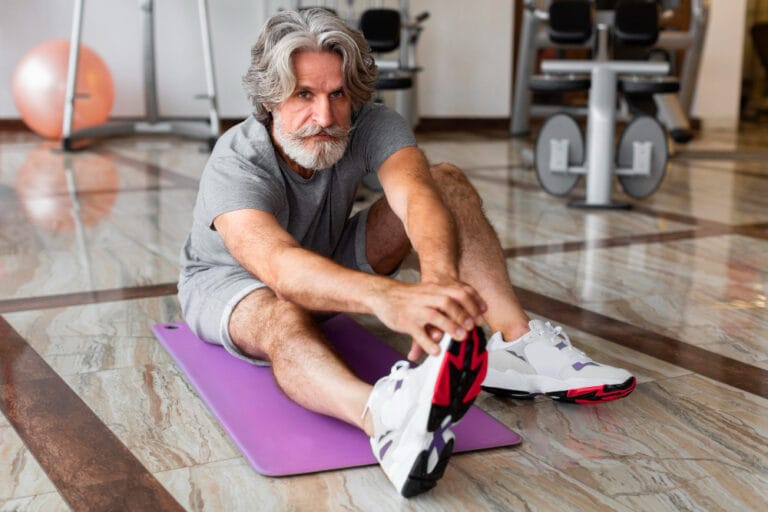FREE SHIPPING OVER $50
Doctor Shocked: The Simple Routine That Helped This 65-Year-Old Throw Away Her Cane

It started with a dull ache in her knee, a nagging discomfort that gradually spread to her hips and lower back. For years, Susan, a vibrant 65-year-old, endured the creeping pain that slowly stole her mobility. Her daily walks became a struggle, and a simple trip to the grocery store required a cane, a symbol of a life she felt was slipping away. She felt defeated, believing that age had finally caught up to her.
Her doctor, a seasoned professional, had seen countless patients like Susan. He prescribed physical therapy and pain medication, but he knew the odds were stacked against a full recovery. Years of wear and tear, coupled with a sedentary lifestyle, had taken their toll. So when Susan walked into his office six months later, without her cane and with a spring in her step, he was genuinely shocked. He stared at her, then at her empty hands, a look of stunned disbelief on his face. “What did you do?” he asked, completely floored by her transformation.
Her secret wasn’t a new drug or an expensive surgery. It was a simple, consistent routine she had committed to for just a few minutes a day. It’s a powerful testament to the fact that you can regain control of your body and reclaim your longevity, no matter your age.
The Root of the Problem: Why Our Bodies Start to Ache
Before we get to the solution, it’s important to understand the common culprits behind leg pain, joint pain, and mobility issues. It’s easy to blame “old age,” but that’s a passive and unhelpful explanation. In reality, the pain is often a direct result of several solvable factors:
- Muscle Weakness: Your muscles are your body’s support system. As we age, if we don’t actively work to maintain them, they weaken. Weaker muscles provide less support for our joints, which leads to instability, pressure, and, eventually, chronic pain.
- Stiffness and Reduced Flexibility: Years of sedentary habits can cause muscles and connective tissues to shorten and tighten. This results in stiffness, a limited range of motion, and makes simple movements painful and difficult.
- Poor Balance and Posture: A lack of core strength and balance can lead to poor posture. This puts undue stress on your spine, hips, and knees, contributing to a domino effect of discomfort and increasing the risk of falls.
Susan’s doctor was amazed because she didn’t just mask the pain; she addressed the root causes. She didn’t just hope for a better life; she actively built a stronger body.
The Simple Routine That Changed Everything
Susan’s routine was a beautiful synergy of three key pillars: gentle movement, targeted strength, and focused balance. She didn’t spend hours in a gym. She simply dedicated a few minutes each day to these practices, which she performed right in her own home.
1. Gentle, Daily Stretching for Mobility
The first part of Susan’s routine focused on improving her flexibility. She learned that a stiff body is a painful body, and by lengthening her muscles, she could reduce tension and regain her range of motion.
- Why It Works: Stretching improves blood flow to your muscles and joints, delivering much-needed oxygen and nutrients. This helps reduce inflammation and makes movement feel less strained.
- The Routine:
- Hamstring Stretch: Sitting in a chair, she would extend one leg straight out with the heel on the floor. Keeping her back straight, she would lean forward from the hips until she felt a gentle stretch in the back of her leg. She held this for 30 seconds on each side.
- Quad Stretch: While standing, she would hold onto a chair for support. She would bend her knee and grab her ankle, gently pulling her heel toward her glute. This stretches the quadriceps, the muscles in the front of the thigh that are crucial for walking. She held this for 30 seconds on each side.
- Calf Stretch: Facing a wall, she would place her hands on it for support. She would step one foot back, keeping both feet pointing forward, and bend her front knee. She held this stretch for 30 seconds, feeling the pull in her calf.
2. Low-Impact Strength Training for Support
This was the most crucial part of Susan’s plan. She learned that strong muscles act as a natural brace for her joints. By building strength in her legs and core, she took the pressure off her aching knees and hips.
- Why It Works: Strengthening the muscles around your joints provides stability and protection. Stronger glutes, quads, and hamstrings absorb the impact of walking and standing, allowing your joints to move more freely and without pain.
- The Routine:
- Chair Squats: Susan would stand in front of a chair with her feet shoulder-width apart. She would slowly lower herself as if to sit, but just before her bottom touched the chair, she would stand back up. She started with 5 repetitions and gradually worked her way up to 15. This simple exercise builds crucial leg and glute strength.
- Wall Push-Ups: Facing a wall, she placed her hands on it a little wider than her shoulders. She then leaned in, bending her elbows, and pushed herself back. This exercise strengthens the chest and shoulders, improving upper body stability and posture.
- Glute Bridges: Lying on her back with her knees bent, she would lift her hips toward the ceiling, squeezing her glutes at the top. This exercise is fantastic for strengthening the glutes and lower back, which are essential for supporting the legs.
3. The Forgotten Art of Balance
For Susan, fear of falling was a huge part of her daily life. She discovered that improving her balance not only made her more stable but also gave her the confidence she needed to leave her cane behind.
- Why It Works: Balance training strengthens the smaller, stabilizer muscles in your ankles and feet. It also improves the communication between your brain and your body, making you more responsive and less likely to stumble.
- The Routine:
- Single-Leg Stance: While holding onto the back of a chair for support, Susan would lift one foot off the ground. She started by holding this position for just 10 seconds and gradually increased her time. As she got more confident, she would try it without holding on.
- Heel-to-Toe Walk: She would walk a straight line, placing the heel of one foot directly in front of the toes of the other. This simple drill helps improve stability and coordination.
Making It Your Own: A Path to Your Own Victory
Susan’s story is a powerful reminder that you have the ability to influence your health and longevity. But before you begin, a few key points are essential:
- Consult a Doctor: Always talk to your healthcare provider before starting any new exercise routine, especially if you have a pre-existing condition.
- Start Slow, Be Consistent: The key to Susan’s success was not intensity, but consistency. She started with just a few minutes a day and didn’t push herself to the point of pain.
- Listen to Your Body: Some days, your body will feel better than others. It’s okay to skip a day or modify an exercise. The goal is to build strength and confidence, not to win a race.
Susan’s victory wasn’t about a miracle cure. It was about a renewed commitment to herself. She learned that her body wasn’t failing her; it was simply waiting for her to give it the support it needed. The day she threw away her cane, she wasn’t just getting rid of an aid; she was reclaiming her freedom. That same freedom is within your reach, too.
Related Articles
- The Doctor’s Secret: I Was 67, in Pain, and Ready to Quit… Then I Found These 15 Light Exercises
- No Heavy Weights Needed! A Physical Therapist’s Top 5 Pilates Moves for Glute Transformation
- Build Lean Muscle After 40: These 8 Workouts Are Your Secret Weapon Against Aging
- Men Over 40: Fix Your Neck & Upper Back Pain with These 5 Uncommon Moves (From a Spine Surgeon!)
- Trainer’s Secret: 5 Resistance Band Moves For Full-Body Strength (No Gym Needed!)







